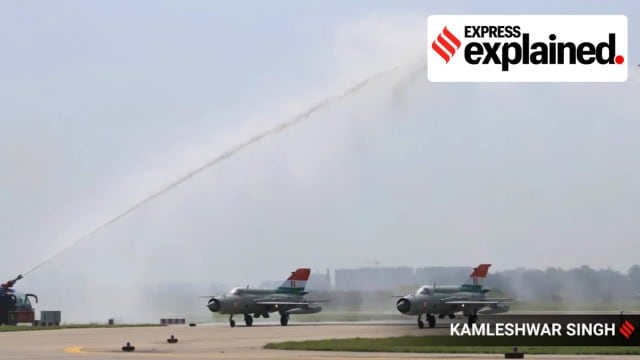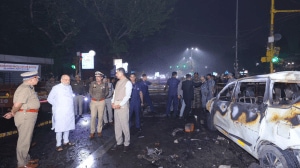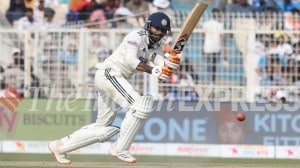As India bids farewell to MiG-21, plans for IAF’s fighter squadrons
The aged aircraft with a chequered history were once the backbone of the Indian Air Force. That they have remained in service for more than six decades speaks to enduring challenges in front of the IAF
 IAF MiG-21 farewell:
Final rehearsal at Airforce Station, Chandigarh on Wednesday. The six MiG-21s of No. 23 Squadron, which will participate in the final fly past ceremony, will be given a water cannon salute after they land. (Express Photo by Kamleshwar Singh)
IAF MiG-21 farewell:
Final rehearsal at Airforce Station, Chandigarh on Wednesday. The six MiG-21s of No. 23 Squadron, which will participate in the final fly past ceremony, will be given a water cannon salute after they land. (Express Photo by Kamleshwar Singh)Indian Air Force MiG-21 farewell: The Indian Air Force (IAF) on Friday (September 26) bid farewell to its iconic MiG-21 fighter jets. The final two MiG-21 squadrons, the No 23 (Panthers) and the No 3 (Cobras), which together operate some 36 jets, retired in Chandigarh during a decommissioning ceremony on Friday.
The retirement further depletes IAF’s dwindling fighter squadron strength. The fact that the Soviet-era fighter, with its chequered history, has remained in service for so long is testimony to enduring challenges in front of the Air Force.
MiG-21: IAF’s six-decade-old workhorse
 When they entered service in 1963 as IAF’s premier interceptors — fighters used for defensive air-to-air combat, to ‘intercept’ enemy aircraft — MiG-21s were arguably the best fighters on the planet.
When they entered service in 1963 as IAF’s premier interceptors — fighters used for defensive air-to-air combat, to ‘intercept’ enemy aircraft — MiG-21s were arguably the best fighters on the planet.
Over the decades, and through a number of upgrades, the single-engine, single-seater fighters from the erstwhile Soviet Union’s Mikoyan-Gurevich Design Bureau have proved their mettle in several of India’s conflicts, including the 1965 India-Pakistan War, the 1971 Bangladesh Liberation War, and the 1999 Kargil conflict.
In total, India has procured more than 700 MiG-21s of different variants, with the most recent ‘Bison’ (BIS) variant boasting modern avionics and radar, and advanced missiles. The IAF has upgraded more than 100 MiG-21s to BIS specs since 2006.
The BIS upgrades, however, did not address some key issues, most notably with the aircraft’s engines, which, over the years, have been notorious for flaming out without notice. For a single-engine aircraft, this has been a major flaw.
As per government data, more than 500 MiG-21s have crashed in the last 60 years, killing at least 170 pilots. More than 20 aircraft have crashed since 2010.
That said, many senior IAF officers, especially those who have flown the aircraft, say that given the sheer number of flying hours that MiG-21s have seen, their safety record is not as poor as it is made out to be.
Challenge before IAF: dwindling squadron strength
With the retirement of the MiG-21s, the IAF is now down to a fighter squadron strength of 29, less than 70% of the Air Force’s sanctioned fighter squadron strength of 42 (this number has never been met).
This means that in case of a two-front conflict with Pakistan and China, India will be woefully short of fighters. Pakistan currently has an estimated fighter squadron strength of 20-25, whereas China has an estimated fighter squadron strength of more than 60. A squadron comprises 16-18 jets.
Unless new aircraft are inducted soon, the IAF’s squadron strength may continue to go down, with many of its older jets, including MiG-29s, Jaguars, and Mirage 2000s, set to be phased out by 2035.
Therefore, much of the current focus has been to establish a robust air defence, and induct capable surface-to-air and surface-to-surface weapon systems. These, military strategists believe, are essential for India’s combat readiness in the time being.
India, despite opposition from the US, went ahead and inducted Russian S-400 mobile surface-to-air missile (SAM) systems. India has also developed its own indigenous Akashteer air-defence system. Both performed admirably during Operation Sindoor.
Tejas, AMCA & a foreign fighter: plans for rebuild
Plans to bolster the IAF’s depleting fighter squadron strength depend on the planned induction of a range of fighter jets — both indigenously-built and sourced from global defence majors.
The IAF has two operational squadrons of the indigenous Light Combat Aircraft (LCA) Tejas Mk1. It is set to receive an additional 180 Tejas Mk1A jets from the state-owned Hindustan Aeronautics Limited (HAL). This includes an initial order of 83 jets, the Rs 48,000 crore contract for which was signed in February 2021, and an additional order of 97 jets that was signed Thursday.
The Mk1A jets boast several upgrades, including the integration of an advanced AESA radar, an Advanced electronic warfare (EW) suite with jammers, and beyond visual range (BVR) capabilities with integration of Derby and indigenous ASTRA missiles.
HAL is also developing the Tejas Mk2 jets as well as the Advanced Medium Combat Aircraft (AMCA) for the IAF. The latter, a fifth-generation stealth fighter, is scheduled to be inducted into the Air Force in the next decade.
In the meantime, the IAF has been trying to buy 114 fighters from a global defence major. Recent internal discussions suggest that the Dassault Rafale is the current frontrunner.
Under the deal, a few jets may also come in a flyaway condition, providing an immediate boost to India’s fighter strength. The rest will likely be manufactured in India in collaboration between France’s Dassault and Indian firms.
India also plans to upgrade 84 of its Su-30MKI fighter jets under the Super-30 program.
Delays and more delays: an enduring challenge
The IAF has long been plagued by delays in development and delivery of aircraft. The MiG-21 has remained in service for more than a decade after the initially planned phase out dates, in no small part due to the IAF not being able to induct new aircraft to replace the old workhorse.
The LCA program, which eventually led to the development of Tejas, was first conceived in the 1980s. Two orders were placed to procure 40 Tejas Mk1 jets in 2006 and 2010; 38 have been delivered so far.
The delivery of the first two Tejas Mk1A aircraft is likely to take place in October, this time after a two-year delay. The reason: the delayed procurement of the F404 engine from US defence major GE Aerospace, as well as issues in weapons and radar integration.
HAL plans to produce 16 Tejas fighters next year onward provided engine deliveries from the US are ons schedule. The original plan was to complete all deliveries by 2030; even if HAL is able to keep up with 16 manufacturing 16 aircraft a year, deliveries are now set to run into the mid-2030s.
Negotiations between HAL and GE for co-production of the F414 engines for the Tejas Mk2 jets remain slow. While a deal, in which GE agreed to 80% technology transfer, was signed more than two years ago, the negotiations are still underway.
Meanwhile, AMCA is still in the development stage: even a prototype may be a few years away still. A deal for the procurement of the 114 fighter jets to bolster India’s squadron too has not been signed yet.






































